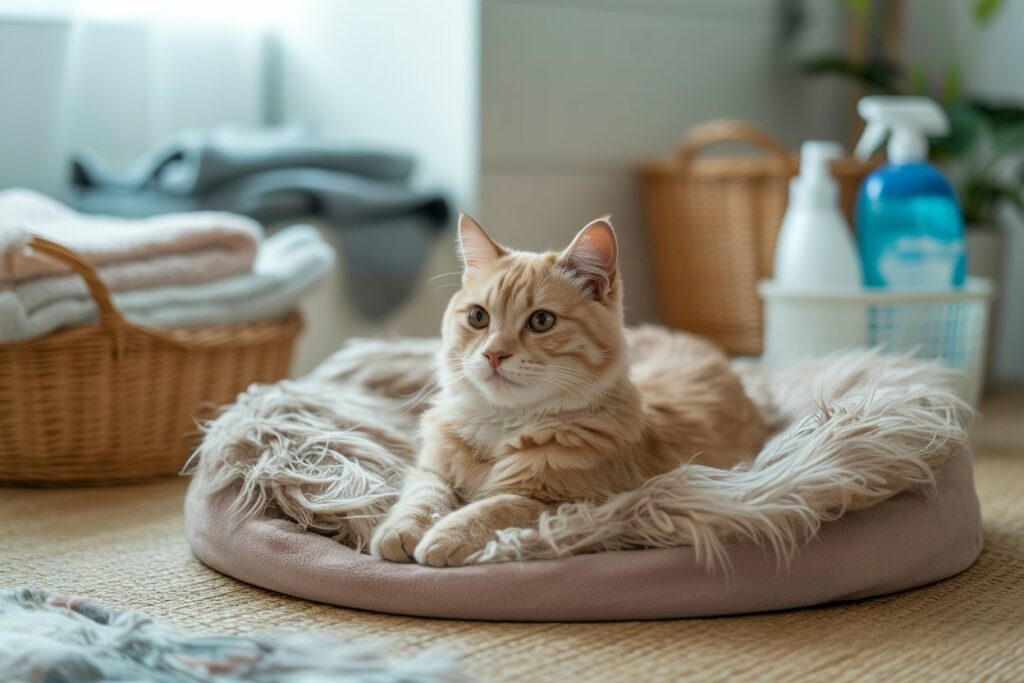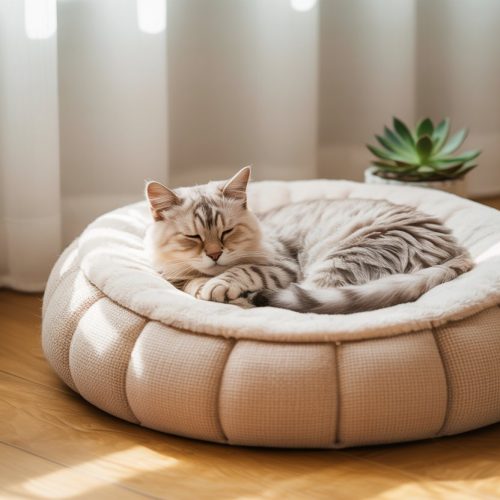
As a loving cat owner, you want your furry companion to enjoy a safe, hygienic, and cozy resting space. But here’s the truth — your cat’s bedding is a magnet for fur, dander, dirt, bacteria, and even parasites. If you do not clean regularly, it can become not only uncomfortable for your cat but also a source of odor and allergens in your home.
In this complete guide, we’ll walk you through the most effective ways to clean and maintain your cat’s bedding. From weekly wash routines to deep cleaning tips, and even how to handle accidents or illness, we’ll cover everything you need to know.
Why It’s Important to Clean Your Cat’s Bedding
Cats are naturally clean animals, but that doesn’t mean the environment around them stays pristine. Their fur, paws, and skin carry oils, allergens, and even bacteria that transfer to their bedding over time. Here’s why it’s essential to clean it regularly:
- Prevents Odors: A dirty cat bed quickly starts to smell, especially in humid environments.
- Controls Allergens: Pet dander builds up and affects both your cat and anyone with allergies in your home.
- Reduces Fleas and Parasites: Regular cleaning helps eliminate flea eggs or mites hiding in fabrics.
- Prevents Skin Irritation: Dust, mold, and oils on bedding can lead to skin problems in sensitive cats.
- Keeps the Home Clean: A clean bed means less hair and dirt being spread around your home.
How Often Should You Clean Your Cat’s Bedding?
The frequency depends on a few factors: your cat’s health, how much they shed, and whether they spend time outdoors. As a general rule:
- Lightly used bedding: Wash every 2 weeks.
- Heavily used bedding: Clean weekly.
- After illness, accidents, or flea treatment: Clean immediately and more thoroughly.
- Blankets and cushions: Spot clean regularly and deep clean every 1–2 weeks.
Remember, your nose knows. If you smell anything off, it’s time to freshen up the bedding.
Step-by-Step Guide to Washing Cat Bedding
Before you toss it in the machine, it’s important to follow a step-by-step process to ensure you’re cleaning it the right way.
1: Shake Off Loose Hair and Debris
- Take the bed outdoors and give it a good shake.
- Use a lint roller or vacuum to remove stubborn fur.
- Brush with a pet hair remover for thorough surface cleaning.
2: Check the Label
- Always read the care label on the bedding.
- Some beds are machine washable, while others may require hand washing or dry cleaning.
3: Choose Pet-Safe Detergent
- Use fragrance-free, chemical-free detergent.
- Avoid harsh cleaners, bleach, or anything containing ammonia — these can irritate your cat’s skin and nose.
4: Wash on Gentle Cycle
- Use warm or hot water, depending on the instructions.
- Run a gentle cycle for machine-washable beds.
5: Rinse Thoroughly
- Always run an extra rinse cycle to ensure no detergent residue remains.
- Detergent residue is one of the leading causes of feline skin issues.
6: Dry Completely
- If the bed is dryer-safe, use a low-heat setting.
- Otherwise, air dry in a sunny, well-ventilated spot.
- Make sure the bed is fully dry to prevent mold or mildew.
Hand Washing Cat Beds: A Gentle Alternative
Your cat’s bed isn’t machine-washable or has delicate fabric, so hand washing is a safer option.
How to Hand Wash:
- Fill a bathtub or sink with warm water.
- Add pet-safe detergent and soak the bedding for 10–15 minutes.
- Gently scrub with a soft brush.
- Rinse thoroughly with clean water.
- Squeeze out excess water without wringing harshly.
- Air dry in sunlight or indoors with good airflow.
How to Spot Clean Cat Bedding Between Washes
Don’t need to wash the bed every time your cat tracks in dirt. Spot cleaning is ideal for quick refreshes.
Best Spot Cleaning Tips:
- Use a damp cloth with mild soap to clean stained areas.
- Dry with a towel or place near a fan.
- Use a fabric-safe pet deodorizer for lingering smells.
- For urine spots, use an enzyme-based cleaner to break down odor-causing proteins.
Handling Accidents: Urine, Vomit, or Flea Infestations
Accidents happen. Whether your cat is sick, recovering from surgery, or dealing with fleas, you’ll need a more targeted cleaning approach.
For Urine or Vomit:
- Blot the area with paper towels to absorb liquid.
- Rinse with cold water.
- Apply an enzyme cleaner and let it sit.
- Machine wash or hand wash as usual.
For Fleas:
- Wash all bedding in hot water (at least 60°C / 140°F).
- Dry on high heat if the fabric allows.
- Vacuum nearby areas and use flea treatments as recommended by your vet.
Tips to Maintain Fresh Cat Bedding Longer
Cleaning is only part of the process — maintenance helps extend the life of the bedding and keeps your home smelling fresh.
Simple Maintenance Habits:
- Vacuum your cat’s bed every 2–3 days to remove fur and dust.
- Keep a rotation of 2–3 beds so your cat always has a clean one.
- Brush your cat regularly to reduce shedding.
- Wash blankets or covers more frequently than the full bed.
- Place the bed in a dry, elevated area to avoid dirt accumulation.
What Materials Are Easiest to Clean?
Choosing the right bed material can make your life easier. Here are some of the best options:
- Microfiber: Durable, breathable, and machine washable.
- Fleece: Soft, retains warmth, and cleans easily.
- Cotton: Hypoallergenic and natural, ideal for sensitive cats.
- Removable Covers: Beds with zip-off covers are the easiest to clean and maintain.
Avoid materials that trap fur or are hard to dry, such as wool blends or thick faux fur, unless you’re prepared for high-maintenance cleaning.
Can You Use Disinfectant Sprays?
Not all disinfectants are pet-safe. Many commercial sprays contain chemicals that can harm your cat when inhaled or licked off.
Use only pet-safe disinfectants or natural solutions like diluted vinegar, hydrogen peroxide, or baking soda.
Signs It’s Time to Replace the Bedding
The cleanest cat bed won’t last forever. Keep an eye out for these signs:
- Persistent odors that don’t go away after washing
- Torn fabric or exposed stuffing
- Moldy or mildewy smell
- Allergies or skin reactions in your cat
- Flattened, worn-out padding
If you notice any of these, it’s best to invest in a new bed that offers better hygiene and support.
Final Thoughts: Clean Bed, Happy Cat
Your cat’s bedding may seem like a chore, but it plays a huge role in your cat’s overall comfort and well-being. Keeps your home smelling fresh, protects your pet’s health, and shows how much you care about their happiness.






